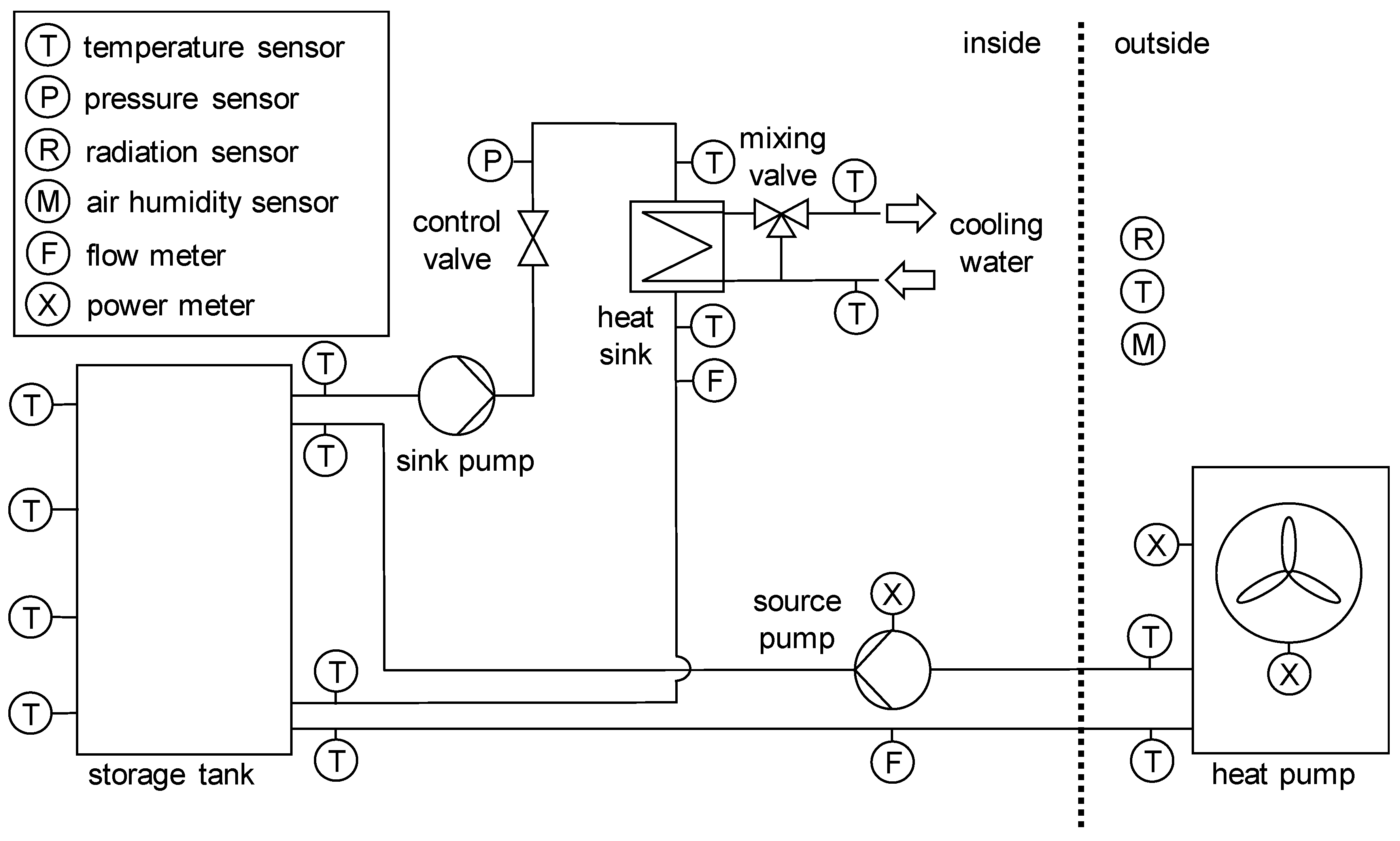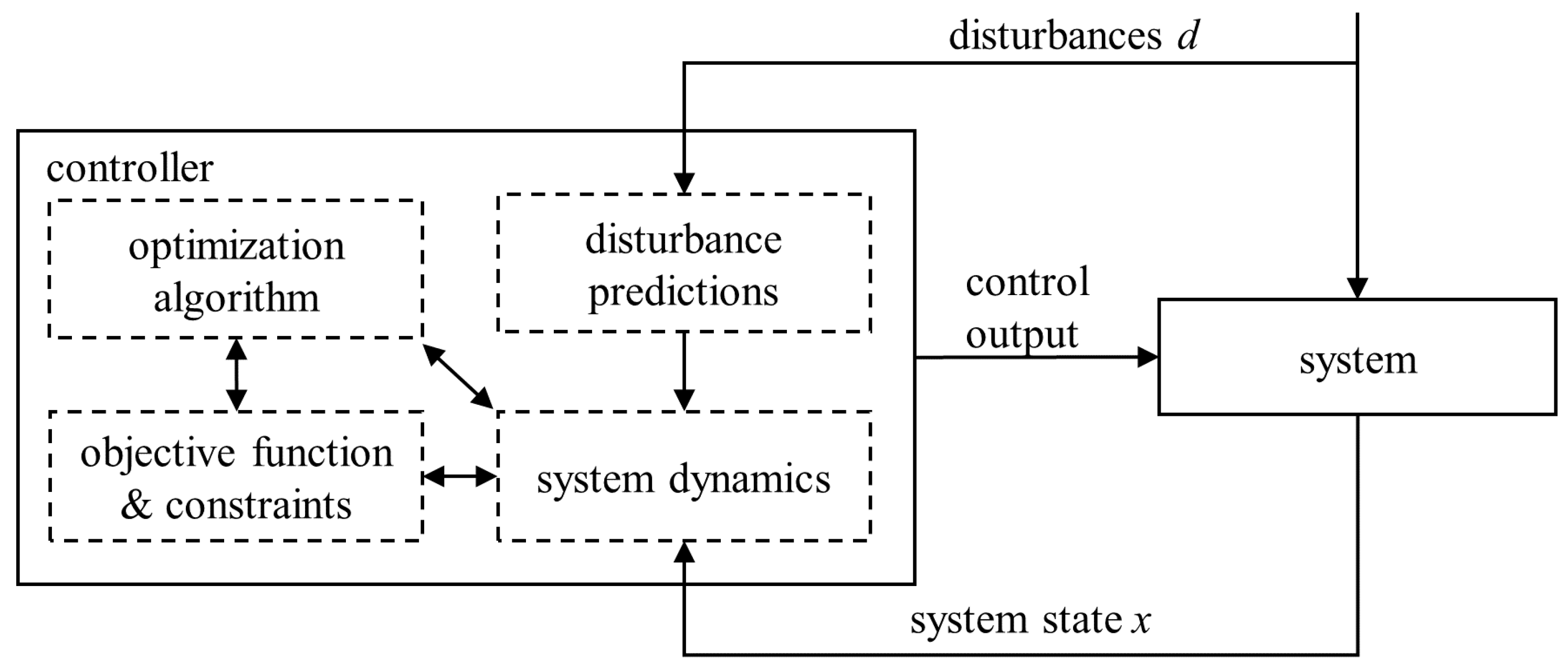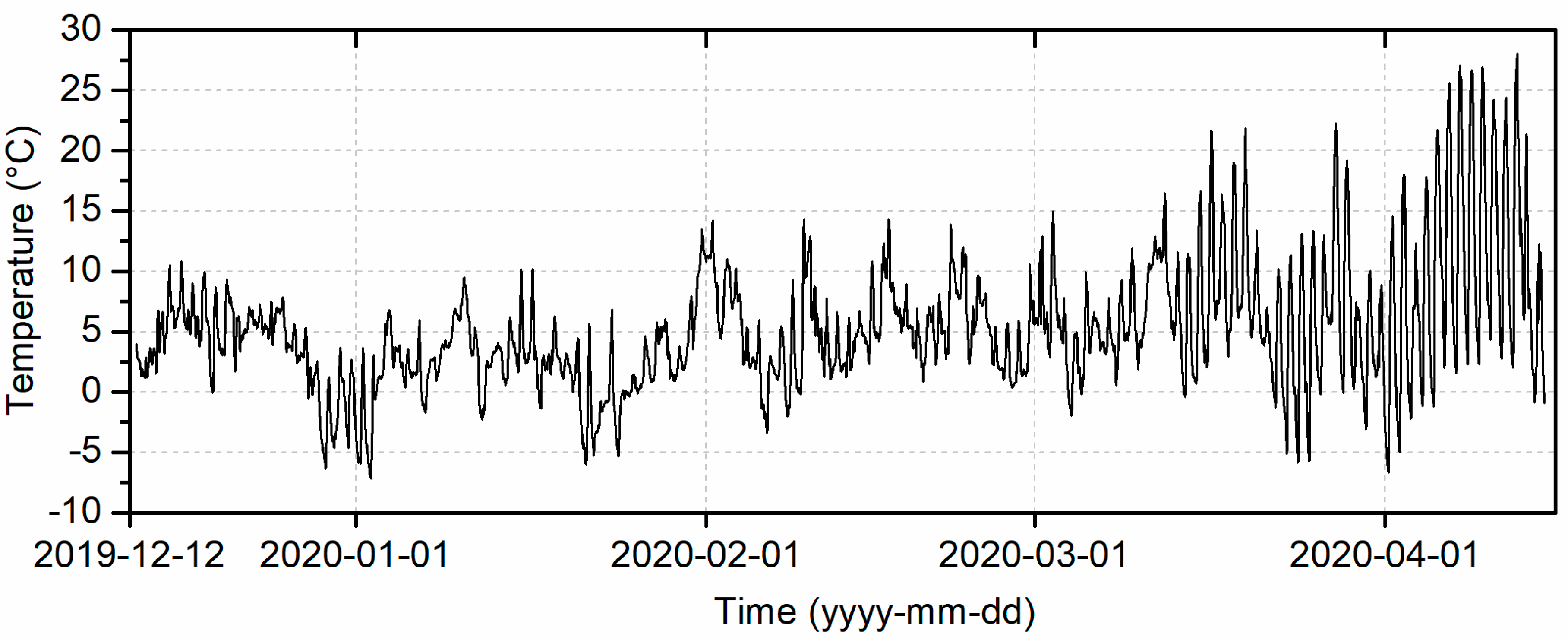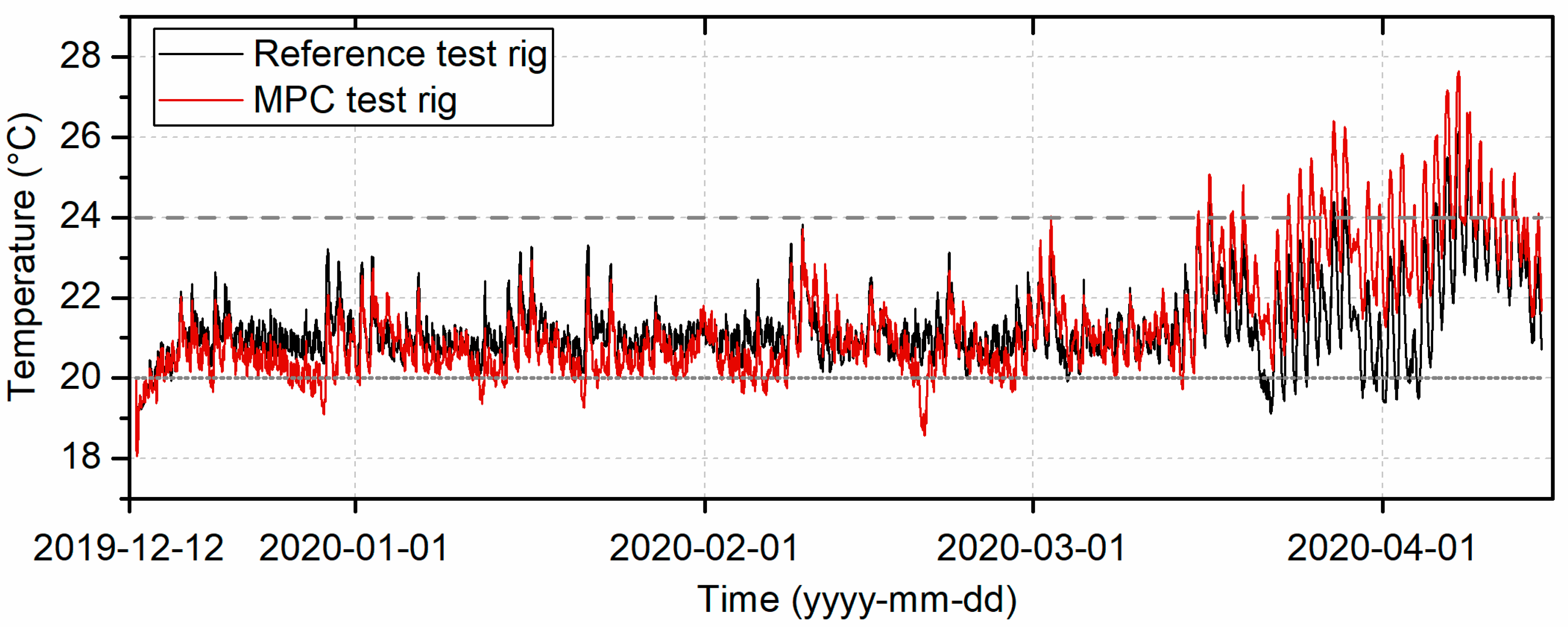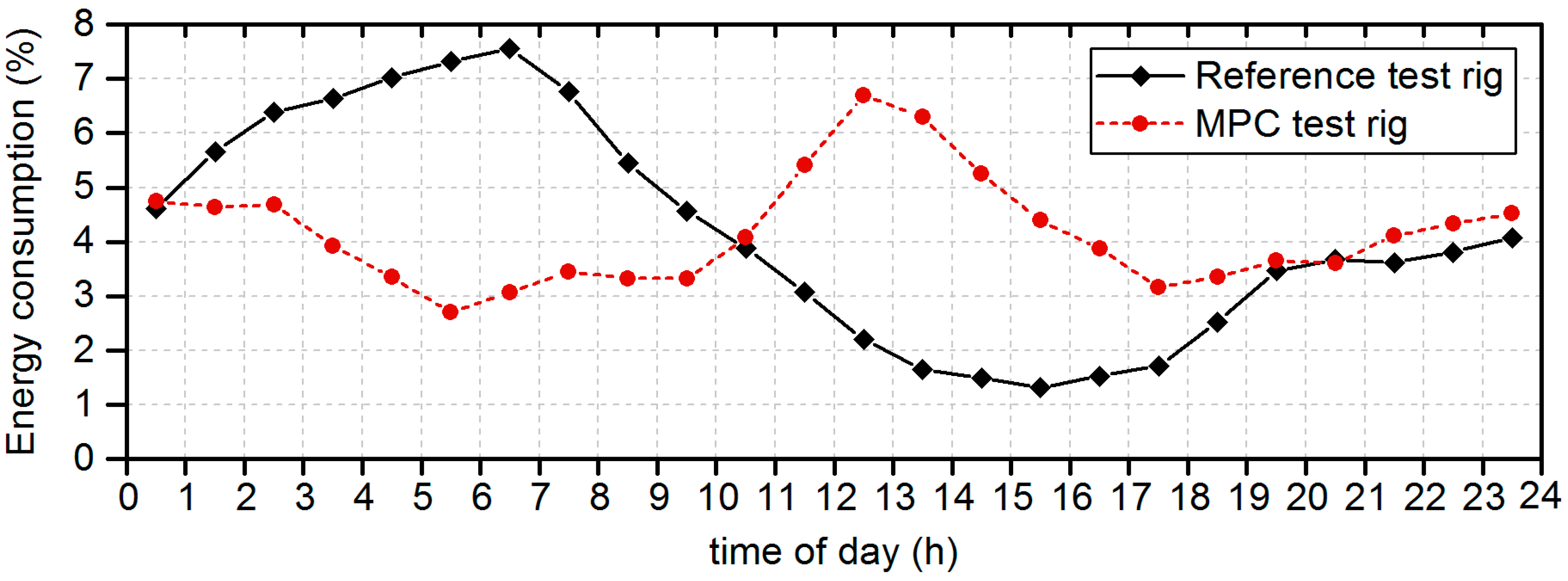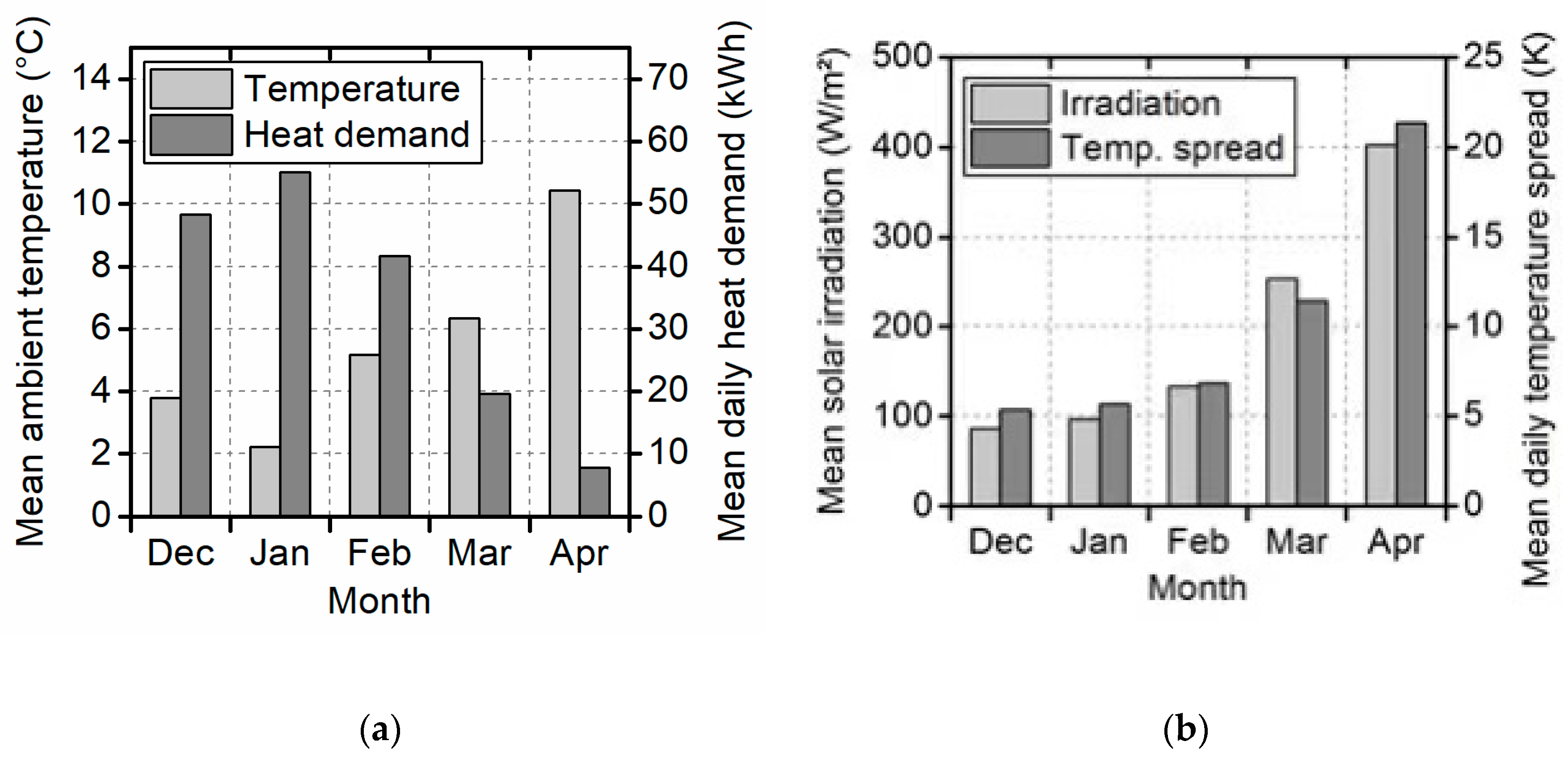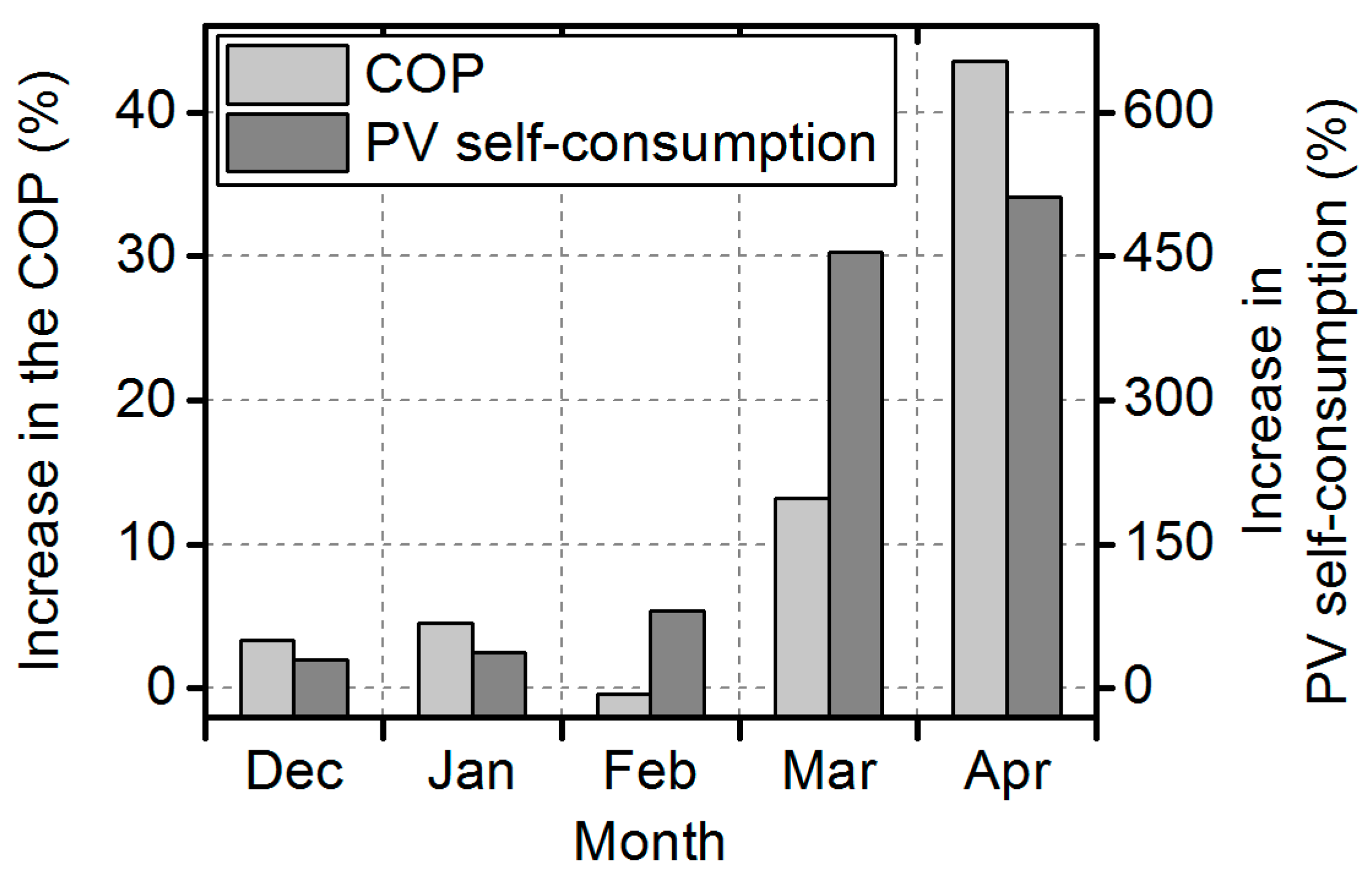1. Introduction
In developed countries, residential and commercial buildings cause up to 40% of the total final energy consumption. Heating, ventilation, and cooling (HVAC) energy consumption is showing particular growth [
1]. In order to counteract this development and to reduce the environmental impact of HVAC systems, efficient control methods are necessary [
2]. The impact of control systems on energy consumption due to HVAC systems is explored in various scientific publications. For example, Salvadori et al. [
3] recently investigated the energy savings that can be achieved by different control concepts of the heating system in the case of an office building. Within the context of promising control methods, model predictive control (MPC) is of particular interest, as it is able to consider multiple objectives [
2,
4]. The high energy saving potential of MPC in comparison to common control methods has already been shown in various simulation studies. In particular, Oldewurtel et al. [
5] presented a comprehensive system variation.
Next to the control of conventional heating systems, MPC is a suitable method for controlling electric heat pumps [
6]. Heat pumps currently show significantly increasing heating system market shares, as the environmental impact of heat pumps in operation is low [
7]. Simulation studies of single-family house heat pump systems proved that energy costs can be reduced by the application of MPC [
8,
9]. Kajgaard et al. [
8] indicated the potential of energy cost reduction of up to 12% while Halvgaard et al. [
9] stated a 35% reduction potential for heat pump load shifting and varying electricity prices. A publication by Bechtel et al. [
10] revealed cost savings of up to 24.3% for single family houses in Luxembourg depending on the heat storage size, when variable electricity prices based on the electricity market are applied. Further studies verify the economic and energetic viability of MPC application for cooling purposes [
11] or if the heat pump is combined with a micro heat and power system [
12], a fuel cell [
13], or solar heat generation [
14]. However, heat pumps are assumed to be primarily combined with photovoltaics (PV) in future residential energy systems [
15], as the generated electric energy can be directly converted into useful heat avoiding grid feed-in. In this context, experiments were conducted by Franco and Fantozzi [
16] in order to analyze the operating performance of the integration of PV and ground source heat pump for a residential building.
As stated by Salpakari and Lund [
17], the application of MPC is beneficial for combined heat pump and PV systems, as the amount of PV electricity feed-in is reduced by up to 88%. The self-consumption of PV electricity can be profitable in case of electricity prices which extend electricity grid feed-in remuneration. The authors [
17] achieved a 25% energy cost reduction in the case of flexible market electricity prices of Finland and in comparison to a rule-based controller. Furthermore, CO
2-emissions and feed-in peaks could be reduced [
18]. In a similar study, Fischer et al. [
19] achieved cost savings of 6% to 11% for constant electricity prices and up to 16% for variable electricity prices in comparison to a common rule-based controller. Rastegarpour et al. [
20] investigated different MPC approaches for modulating air-to-water heat pumps in radiant-floor buildings. For the considered application, nonlinear MPC has the potential to save up to 6% energy and improve the comfort by 4% with respect to standard MPC. For MPC online optimization, calculation speed and reliability are crucial parameters. In this regard, Gelleschus et al. [
21] performed a one-year simulation for a home energy system consisting of a heat pump, a thermal storage, a photovoltaic system, and a battery and compared different algorithms for solving the underlying optimization problem. In a further study [
22], a multi-objective home energy management concept using stochastic mixed-integer linear programming and MPC was presented for a grid-coupled home energy system with a PV plant, a battery, and a combined heat pump/heat storage device for domestic hot water supply. It is shown that this concept reduces energy costs as well as the maximum grid loads both on feed-in and demand sides. Hence, it offers a potential for infrastructure cost reduction, if adopted by a large number of prosumers and can lead to a positive effect on the lifetime of the battery.
In contrast to theoretical studies, experimental studies are currently only available in limited numbers. However, experiments should be carried out for a more detailed understanding and potential assessment [
6]. Furthermore, experimental studies mostly focus on public buildings [
23,
24], partly with comparison of the measurement results to a reference case simulation [
25]. For the reliability of investigations on the application of MPC in residential buildings, test results should be evaluated by reference experiments. For this purpose, however, two identical residential buildings or suitable test facilities are necessary. Frison et al. [
26] presented such a test facility, including a ground-source heat pump. In a first test of a single day, 3.1% of the energy costs could be saved by applying the MPC. Another suitable system for air-source heat pumps was presented by Péan et al. [
27]. In a three-day test, which could be repeated with a rule-based controller in the identical plant due to the application of a climate chamber, the MPC could save 7% of the energy costs. However, both authors did not consider PV energy production and the optimization of self-consumption by MPC. This was investigated in short-term measurements by Kuboth et al. [
28]. An MPC control algorithm was developed, applied to an air-source heat pump test facility and evaluated. The reference for evaluation was given by a test rig with identical components and common PI-control. Both heat pumps were affected by real weather conditions. In a series of 6 measurements of 120 h each, the MPC algorithm could increase the heat pump coefficient of performance (COP) by a weighted average of 22.2% and the PV self-consumption rate by 234.8%, while the energy costs were reduced by an average value of 34.0% assuming German energy prices.
Overall, it appears that investigations of long-term behavior using an MPC in heat pump control for domestic buildings have been solely performed in theoretical studies based on simulation models. Published experimental studies cover an observation period of a maximum of three days.
Thus, within this article, the promising results deriving from simulations and short-term experiments are to be further evaluated by a long-term measurement applying the identical two test rigs of the short-term measurements. The long-term measurement was carried out in the heating season of the following year over a period of 125 days. Both the short-term and long-term comparison as well as the test duration represent novelties in the experimental investigation of heat pump MPC of detached houses.
3. Model Predictive Control
MPC is a model-based concept to control a system by solving an optimization problem under consideration of an objective function and possible constraints for each time instance of a defined prediction horizon. The general control concept is displayed in
Figure 2.
The respective overall optimum control problem in case of the investigated building energy system is defined in
Section 3.1. A detailed description of the system dynamics, the objective function, and the algorithm applied for weather forecasting is presented in the following subsections.
3.1. Definition of the Optimal Control Problem
The MPC aims to minimize an objective function
J by prediction of the system behavior [
34]. Within this article, this function represents the operational costs of the heat pump. The objective function
J sums up the cost function
ϕ in each time interval
k of the prediction horizon
N. In order to determine the mathematically optimal control sequence within an upcoming control horizon, an optimal control problem resulting from the system dynamics, the objective function, and the constraints have to be solved at every time step
n [
35]. A discretized definition of the optimum control problem is defined by the Equations (3)–(6) [
36]:
The quantities X and U represent the possible system states x and the allowed range of the control vector u. Y represents the set of all allowed combinations.
The definition of the system dynamics, the objective function and the applied forecasting algorithm are described in the following sections. Constraints are considered by including them into the objective function. This constraint softening assures convergence of the optimization algorithm [
33,
37].
3.2. System Dynamics
System dynamics are represented by a state space model. The model simplifies the test rig and the associated building model to four differential equations. A low complexity of the state space model is necessary for reducing the computational effort of real-time optimization.
The differential equations enable a dynamic calculation of the heating water, the floor heating system, and the building zone [
28]. The simplified model considers the thermal capacities of the building, heat transfer between the mentioned zones, heat transfer to the ambient and heat gains by residents, electronics, and solar irradiation. The application of a state observer has been dispensed. The state space model is discretized by the explicit Euler method with a time step size of 300 s, which represents a compromise between computational effort and numerical convergence.
3.3. Objective Function and Optimization
The objective of the MPC optimization is to minimize the energy costs. Costs of the grid purchase of electric energy
cgp are considered to be 0.293 €/kWh, which was a typical value for a single-family house in Germany in 2018 [
38]. In order to match the assumptions of the short-term measurements, PV energy grid feed-in
cfi is refunded at 0.122 €/kWh [
28]. Next to these cost factors, PV curtailment is considered by additional costs
ccu =
cfi. In German PV-systems, the PV generation generally needs to be limited if PV power generation is close to its maximum capacity and PV self-consumption is low. The net grid feed-in maximum is limited to 70% of the maximum PV plant power
PPV,max. If the feed-in would exceed this level, the PV plant power is curtailed in order to prevent high public grid voltage.
In addition to the energy cost factors, constraints are included into the objective function. These constraints aim to define the desired building zone temperature which is limited by a minimum comfort temperature of 20 °C and a maximum comfort temperature of 24 °C.
Comfort limit violation is considered by a penalty cost factor ccon. Undercutting the lower comfort limit ΔT is penalized by 0.5 €/Kh. As the exceedance of the upper comfort limit could be reduced by active ventilation in real systems, a factor of 0.1 €/Kh is applied on upper boundary exceedance within optimization. Thus, a constant violation of the thermal comfort boundaries is prevented, while a slight deviation in case of otherwise inefficient operation conditions is possible.
The resulting objective function is summarized by:
with the control interval duration Δ
t of 900 s. The residual electric load
considers the predictions of the PV power generation
PPV and the prediction of the electric building load
Pb. The nominal electricity consumption by the heat pump
Pel,nom is calculated depending on the ambient air temperature
Tamb and the flow temperature
Tf.
The resulting optimal control problem is solved by a steepest-descent line search algorithm including Armijo’s condition of sufficient descent [
39]. Optimization was carried out every hour with a prediction horizon of 24 h and control time intervals of 15 min. Resulting control signals of 10% or less were reduced to zero, as the heat pumps are not able to generate heat at very low part load.
3.4. Forecasting Algorithm
An algorithm according to Florita and Henze [
40] was applied for weather forecasting in order to ensure comparability to the previous publication [
28]. The algorithm predicts the outdoor temperature and the global horizontal radiation by past measurement data. Measurement values of a 24 h, 48 h, and 72 h backshift in time were equally weighted in order to predict all respective time interval values of the next 24 h. Moreover, a so-called absolute deviation modification of 25% was applied for air temperature prediction in order to adapt to sudden changes of the weather [
28,
40].
Next to the weather prediction, the algorithm was applied to predict the electrical building load and the internal building heat gains. Forecasting of the PV power generation and of the solar building heat gains was carried out by feeding the solar irradiation forecast values into the respective system models.
5. Conclusions
Within this article, the model predictive control of an air-source heat pump in residential systems is compared to a current reference control. For the first time, the evaluation of the controller was performed over a period of several months with comparison to a reference test rig.
For this purpose, two identical test systems were set up, each with one heat pump. One of the heat pumps was controlled by the reference control concept, the other one by an economic MPC algorithm operating in real-time. The heat pumps operate under the influence of real weather conditions. The weather further impacts the identical building models, each one belonging to one of the test rigs. The building models specify the heat consumption in the test systems. The experimental test rig comprising two devices that are identical in construction operating under real weather conditions and considering photovoltaics represents a novelty compared to available experimental setups in the present literature.
An experiment was conducted from December 2019 to April 2020 to show to which extent an MPC is able to increase PV electricity self-consumption to reduce the heat pump electrical energy consumption and energy costs.
The main results are listed in the following:
The applicability and stability of model predictive heat pump control was shown for the major part of one heating season.
The residents’ thermal comfort was slightly reduced, while the heat generation was increased by the application of an MPC.
The heat pump COP was enhanced by 5.4% in comparison to the reference.
The electrical energy consumption of the heat pump was reduced by 4.1%.
The PV electricity self-consumption of the heat pump was improved by 107.7%.
The energy costs of heat pump operation decreased by 9.0%.
The presented scientific data demonstrate that the promising results of short-term experiments by other authors [
26,
27] also arise in long-term experiments. In this regard, the experimental long term-study, that has been conducted in this work for the first time, confirms the findings of simulation studies [
8,
17,
19,
42] too. A further comparison with short-term experiments conducted by application of the same test facility [
28] proves the importance of long-term experiments and shows the dependence of the results on the weather. Hence, in future studies, the effect of using more accurate forecasting algorithms or external and regional weather forecasting on the advantages of the MPC and on the comfort level has to be investigated.
As the potential of MPC was found to be especially high in the transition period of the year, future work will also focus on the combination of space heating and domestic hot water supply.
